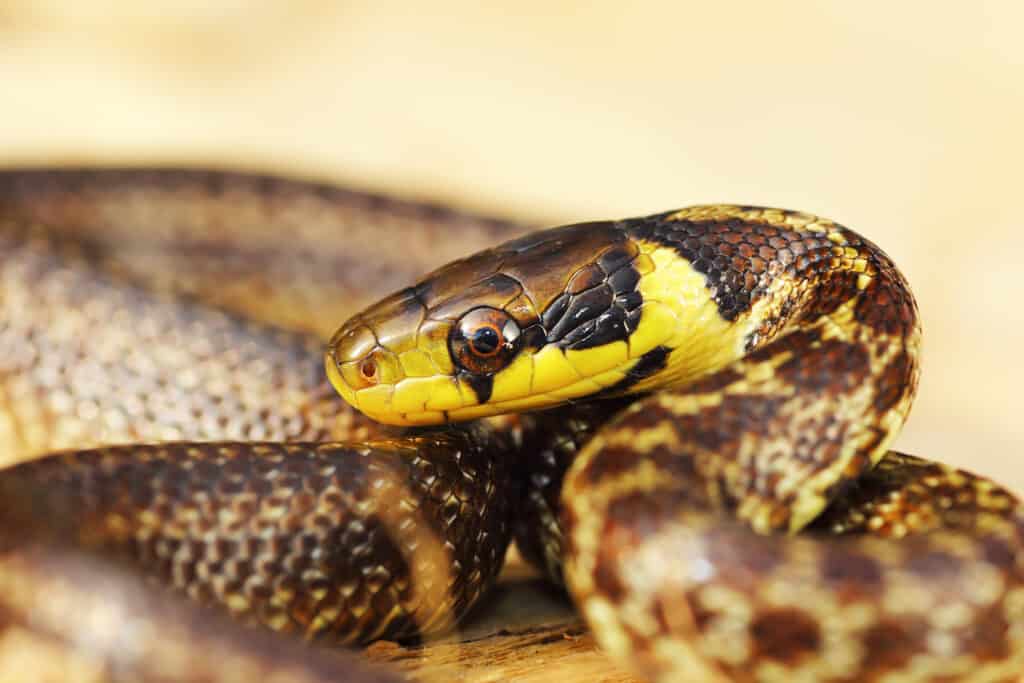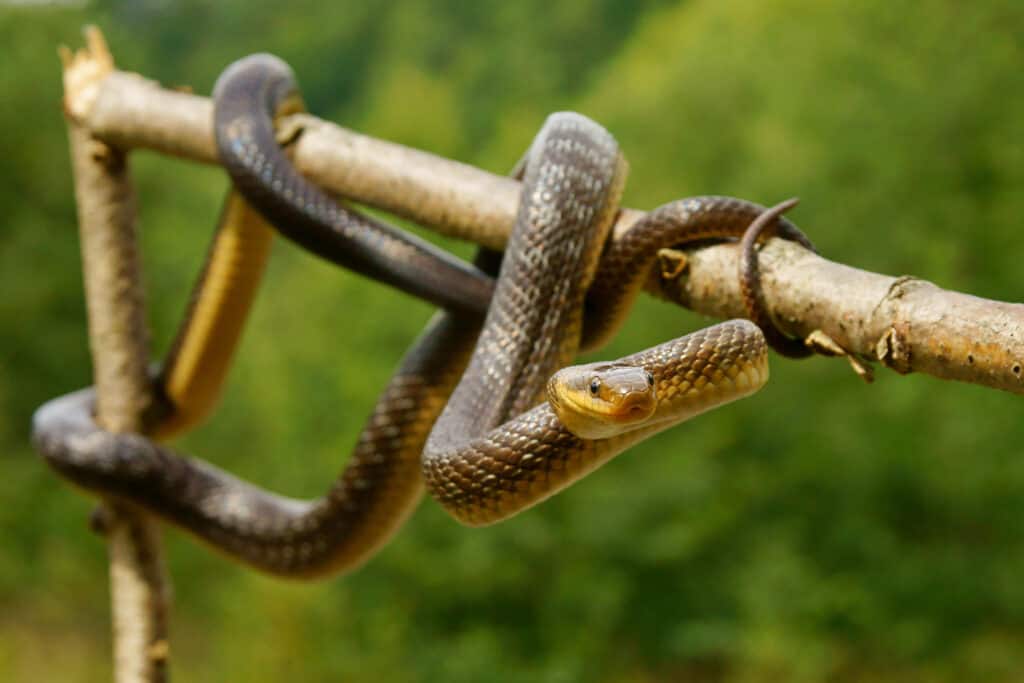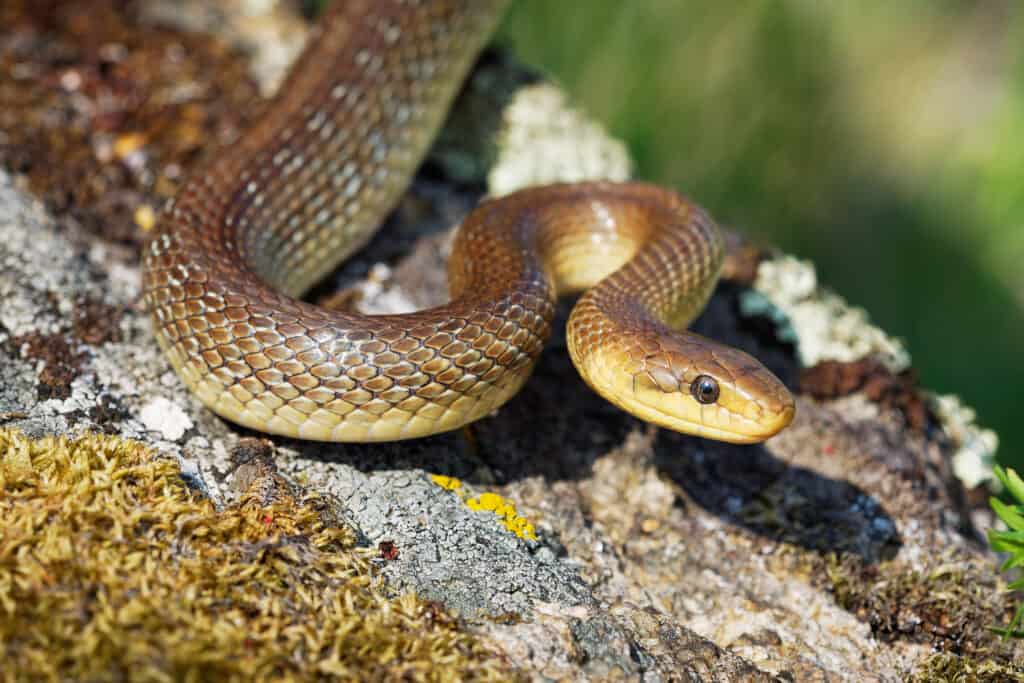Aesculapian Snake
Zamenis longissimus
Advertisement
Aesculapian Snake Scientific Classification
- Kingdom
- Animalia
- Phylum
- Chordata
- Class
- Reptilia
- Order
- Squamata
- Family
- Colubridae
- Genus
- Zamenis
- Scientific Name
- Zamenis longissimus
Read our Complete Guide to Classification of Animals.
Aesculapian Snake Conservation Status
Aesculapian Snake Facts
Aesculapian Snake Physical Characteristics
- Color
- Black
- Olive
- Multi-colored
- Lifespan
- 25-30 years
- Length
- 3-6.6 feet
- Venomous
- No
- Aggression
- Low
View all of the Aesculapian Snake images!

The Aesculapian snake is one of the longest snakes in all of Europe.
The Aesculapian snake may seem large and intimidating, but in reality, this non-venomous species is fairly harmless. The old adage that it is more afraid of you than you are afraid of it happens to be very true in this particular case. This species should not be confused with the Aesculapian false coral snake, which belongs to an entirely separate genus and looks completely different.
4 Aesculapian Snake Amazing Facts

The Aesculapian snake can ascend vertical surfaces straight up. It has been discovered on trees’ top branches as well as roofs.
©iStock.com/taviphoto
- The name of this species is derived from Aesclepius, the Greek god of healing. The snake often hid in temples dedicated to Asclepius and soon became exclusively associated with the god. In fact, the image of the Aesculapian snake wrapped around a rod is a common symbol of medicine and pharmacology today.
- The mating season of the Aesculapian snake takes place between May and June. Rival males will wrestle with each other for access to potential mates. When one male has won, it will begin a ritualized dance with the female. About four to six weeks later, she will lay her clutch of 10 eggs in a moist, warm spot such as hay piles, rotting wood, and old tree stumps.
- The Aesculapian snake has the ability to climb straight up vertical surfaces. It has been found on roofs and even the top branches of trees.
- The Aesculapian snake hibernates in its den for the winter. It also tries to avoid extreme heat.
Evolution and Origins
Aesculapian snakes are a type of rat snake. Scientific findings indicate that ratsnakes likely originated in the late Eocene in tropical Asia, and then spread to the Eastern and Western Palearctic regions by the early Oligocene period.
Rat snakes can be found all over North America, from Southern Canada to Central America. Each species’ environment is different. The ranges and habitats of a few common rat snake species are listed below. This snake, which is the largest of the rat snake species, may be found all over New England and south of Georgia.
In the Philippines, people often mistake rat snakes for cobras, but there is a noticeable difference in body shape between the two types of snakes, with rat snakes being thinner and cobras being stockier.
Different Types
- Black rat snake
- Spilotes pullatus
- Corn snake
- Eastern rat snake
- Gray ratsnake
- Ptyas mucosa
- Rhinoceros ratsnake
- Beauty rat snake
- Gonyosoma oxycephalum
- Great plains rat snake
- Philippine rat snake
- Trans-Pecos rat snake
- Elaphe schrenckii
- Elaphe carinata
- Radiated ratsnake
- Mandarin rat snake
- Ptyas korros
- Japanese rat snake
- Ptyas nigromarginata
- Baird’s rat snake
- Coelognathus flavolineatus
- European ratsnake
- Steppe rat snake
- Aesculapian snake
- Black-banded trinket snake
- Trinket snake
- Ptyas carinata
- Senticolis
- Four-lined snake
- Euprepiophis conspicillata
- Gonyosoma prasinum
- Japanese striped snake
- Red-headed rat snake
- Yellow-red rat snake
- Gonyosoma frenatum
- Pantherophis vulpinus
- Ptyas dhumnades
- Persian ratsnake
- Elaphe bimaculata
- Ptyas fusca
- Gonyosoma jansenii
- Pantherophis gloydi
- Blotched snake
- Transcaucasian ratsnake
- Baja California rat snake
- Indonesian ratsnake
- Ptyas luzonensis
- Italian Aesculapian snake
- Elaphe davidi
- Oocatochus rufodorsatus
- Orthriophis cantoris
Where to Find Aesculapian Snakes

Forests, hills, and other environments with lots of cover are where you can find the Aesculapian snake exclusively.
©iStock.com/SzymonBartosz
The Aesculapian snake is endemic to forests, hills, and other habitats with plenty of covers. Its range extends across most of Southern Europe and small parts of Western Asia from the Atlantic coast to the Black Sea. It is not endemic to the United Kingdom, but many specimens apparently escaped from British zoos and established populations near Wales and London. The London population may have become extinct over time, but other populations have endured. There is a similar species known as the Italian Aesculapian snake that inhabits the southern Italian peninsula.
Scientific Name

The Aesculapian snake’s scientific name is Zamenis longissimus. The Greek word for angry or fierce is zamenis.
©francesco de marco/Shutterstock.com
The scientific name of the Aesculapian snake is Zamenis longissimus. Zamenis is a Greek word that means angry or fierce. Longissimus is a Latin word that means longest. It is a close relative of the Italian Aesculapian snake and the European rat snake. Several subspecies are currently recognized.
Population & Conservation Status
According to the IUCN Red List, the Aesculapian snake is considered to be a species of least concern. While they do appear to be widespread and stable, population estimates are not currently known. Habitat loss from roads, farms, and buildings has traditionally been a threat to this species.
Appearance and Description

Aesculapian Snake – Zamenis longissimus, Elaphe longissima, nonvenomous olive green and yellow snake native to Europe, Colubrinae subfamily of the family Colubridae. Resting on the stone in the vineyard.
©iStock.com/phototrip
The Aesculapian snake has a long, slender body with smooth scales that give it a kind of metallic sheen. They have fairly small heads and round, dark pupils. Measuring up to 6.6 feet in size, it is among the longest snakes in all of Europe.
The skin can come in various colors, including olive yellow, brownish-green, and even black, with regular patterns of white-edged scales along the sides and back. Juveniles, by contrast, have light green or brownish-green skin with darker patterns instead.
Here is how to identify the Aesculapian snake:
- Long, slender body measuring up to 6.6 feet
- Small head with round eyes
- Smooth scales with a metallic sheen
- Olive-yellow, brownish-green, or black skin colors
- Regular blotched patterns on the back and sides with white edges
How Dangerous Are They?
Despite its large and intimidating size, the Aesculapian snake is not very dangerous at all. They do not produce any venom, and their bite isn’t strong enough to seriously damage human skin. If you are bitten by one of these snakes, then you should try to wash out the wound with soap to prevent an infection. It may be a good idea to seek medical care as well.
Behavior and Humans
Aesculapian snakes are not very aggressive toward humans. They would prefer to run away and hide in their crevices when it comes into contact with a person. As long as you don’t attempt to corner or approach this snake, it will not try to defend itself. This snake may try to intimidate its opponent first before striking.
Similar Animals
View all 194 animals that start with AAesculapian Snake FAQs (Frequently Asked Questions)
Are Aesculapian snakes venomous?
The Aesculapian snake does not produce any venom.
How do Aesculapian snakes hunt?
Aesculapian snakes come out from their dens in the early morning or late afternoon to hunt for food. They generally use their speed and agility to surprise their unsuspecting prey. Like many snakes, they have an organ on the roof of the mouth that can interpret scent molecules from the air to help them locate prey. Without venom, they must hold the prey tight in their mouth or coils to prevent it from escaping.
Are Aesculapian snakes aggressive?
This species is not considered to be very aggressive at all. Their ability to hide in crevices and blend in with the environment helps them to evade potential predators. If they are seen, then they will try to run away and hide.
Where do Aesculapian snakes live?
The Aesculapian snake lives in fairly humid locations with plenty of rocks and vegetation to hide in. This includes forests and hills through Southern Europe and Western Asia. There have also been reports of escaped populations near London and Wales.
What do Aesculapian snakes eat?
The Aesculapian snake is carnivorous. Juveniles feed on lizards, insects, and small rodents. As they grow, the snakes begin to transition toward a diet heavy in rats, shrews, moles, and birds and their eggs.
What is the difference between an Aesculapian snake and the Aesculapian false coral snake?
The only real similarities are their size and perhaps some of their behaviors. Besides that, they are completely different. The Aesculapian false coral snake is venomous, lives in South America, and resembles a coral snake. It is also a member of a different genus (but the same family of Colubridae).
Can you keep Aesculapian snakes as pets?
Because of their fairly docile behavior, Aesculapian snakes could be kept as a pet without any fear of danger, but they are not really sold by many pet stores. Care can be a little difficult too. They need just the right temperature, humidity, and habitat size to thrive. If their care is not properly met, then they can easily suffer. This species can be fed on a fairly standard diet of rodents, just like many other types of snakes.
How long do Aesculapian snakes live?
The typical lifespan of the Aesculapian snake is about 25 to 30 years.
Thank you for reading! Have some feedback for us? Contact the AZ Animals editorial team.


















